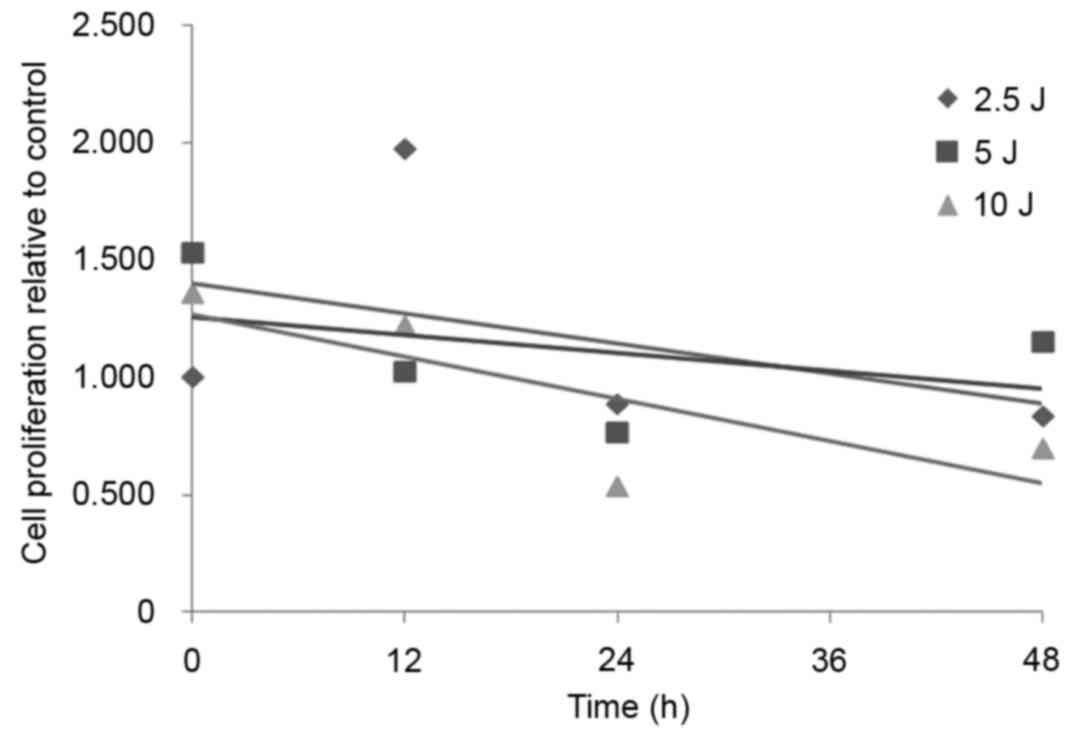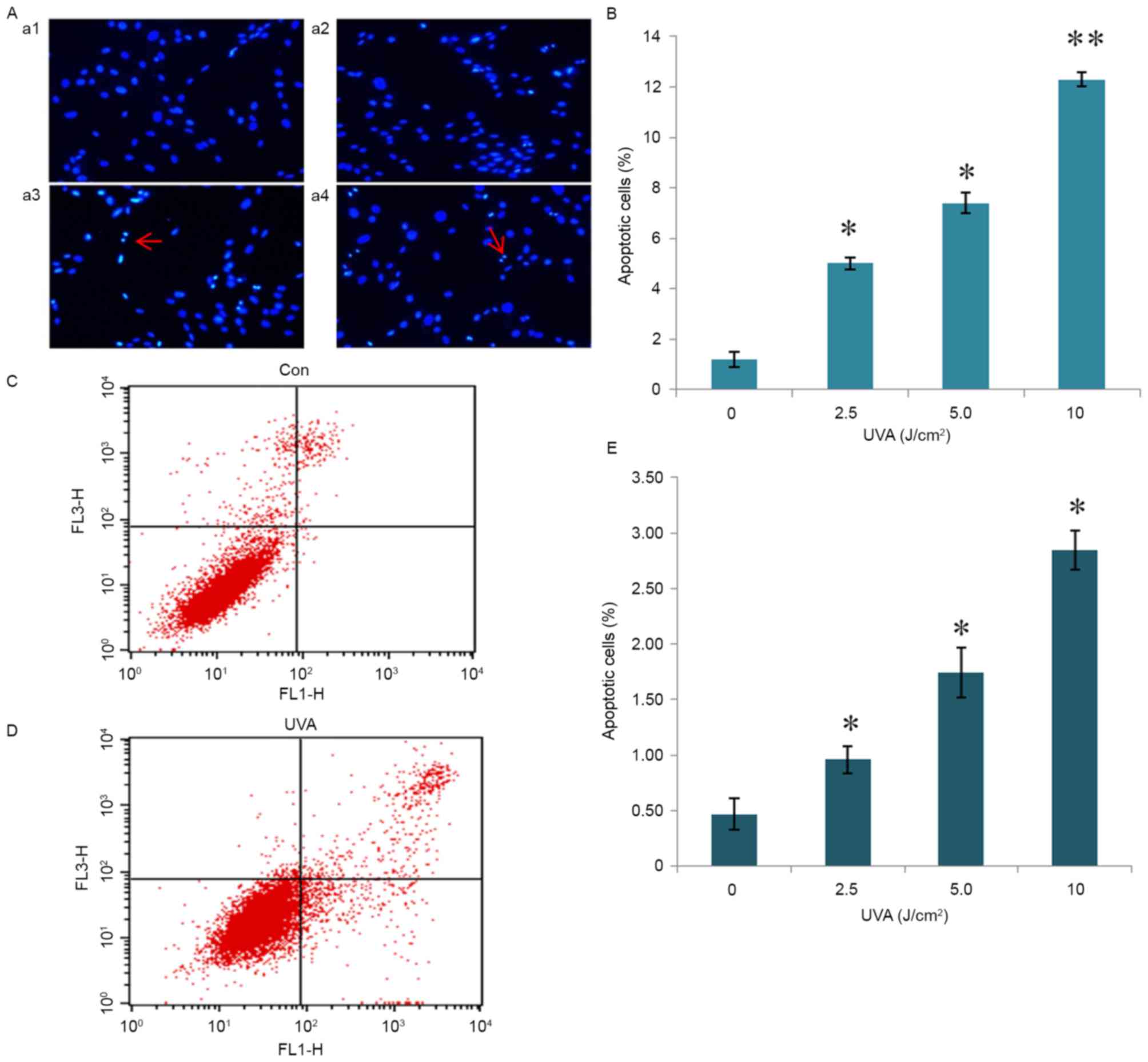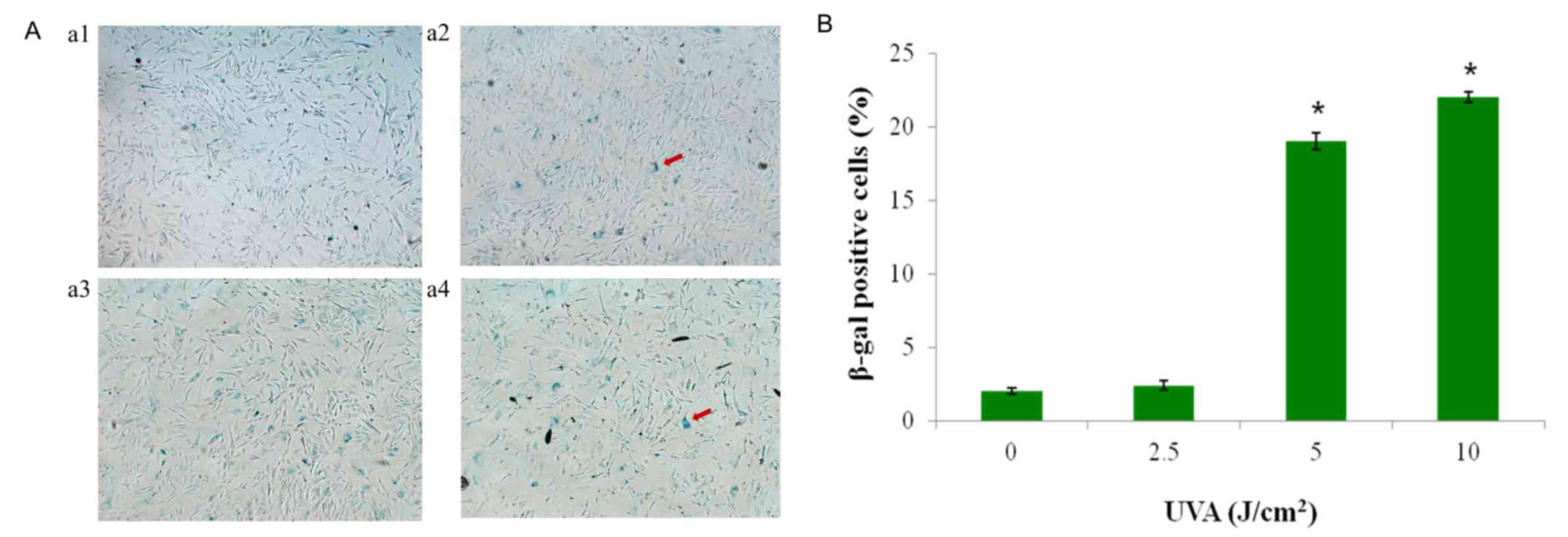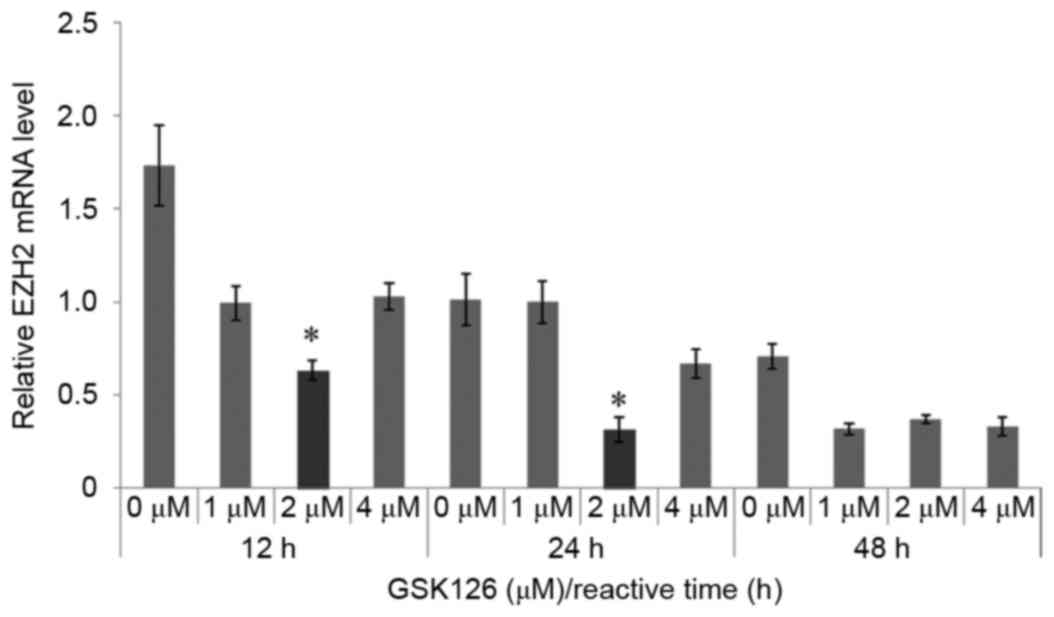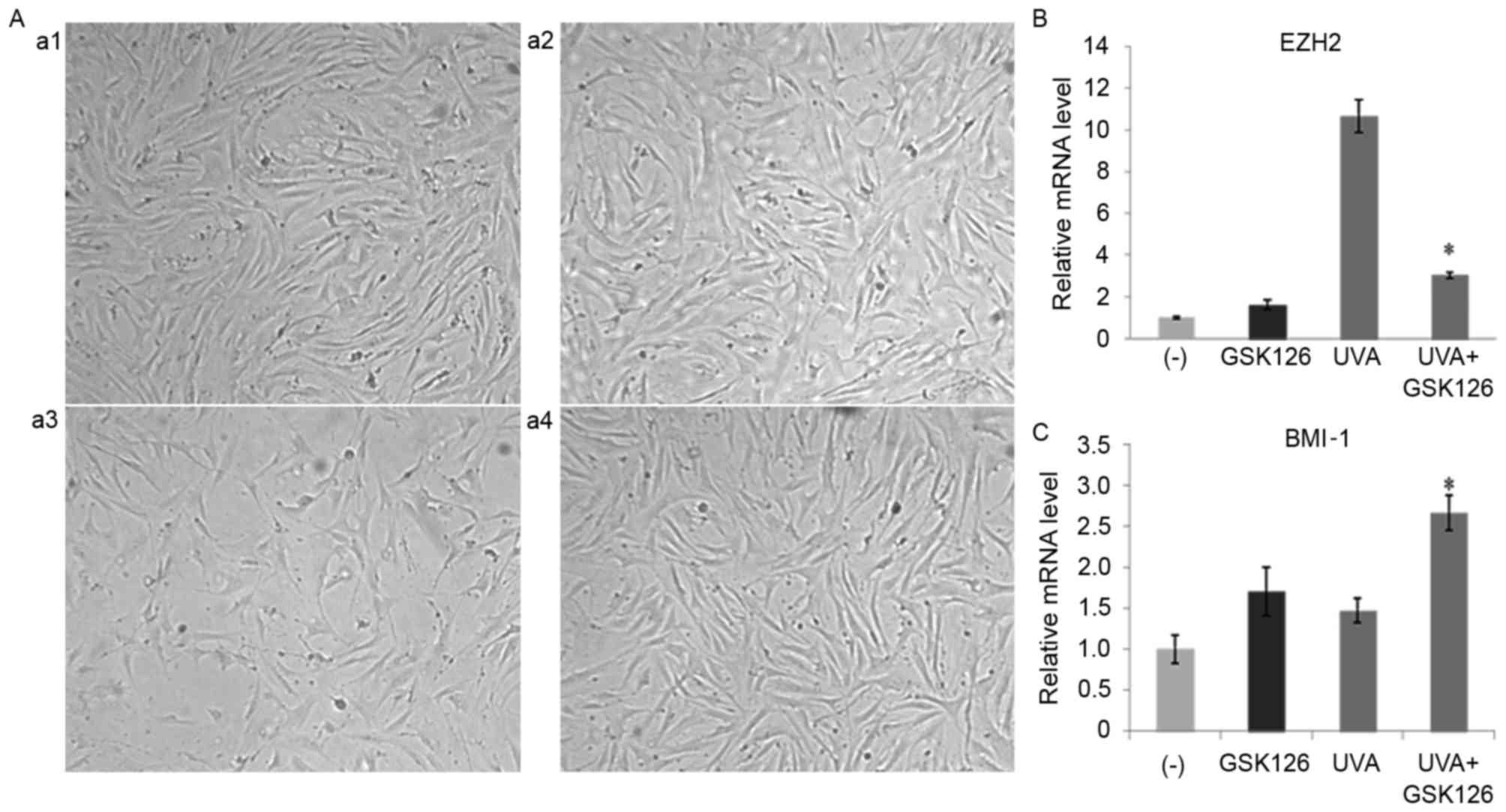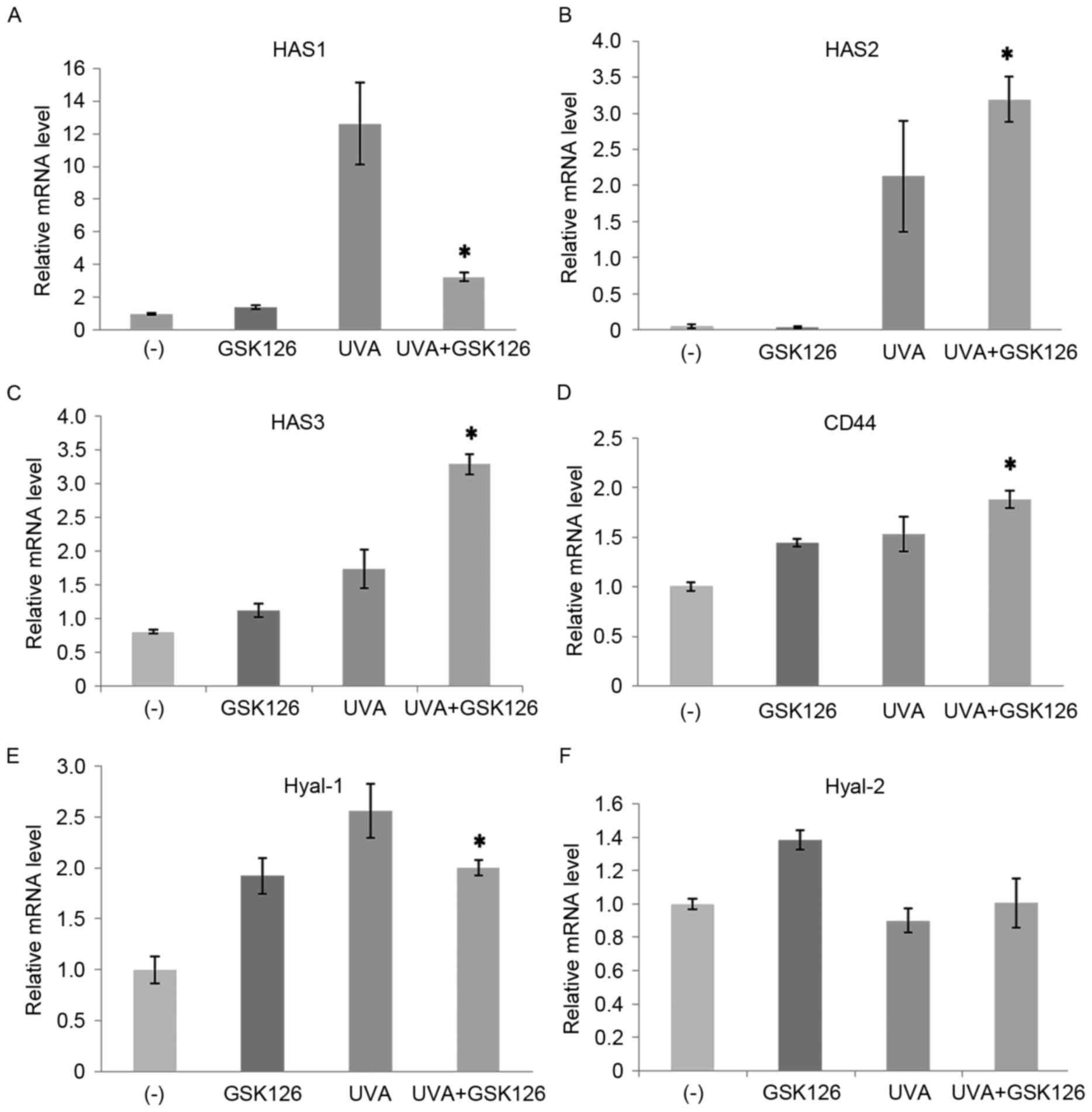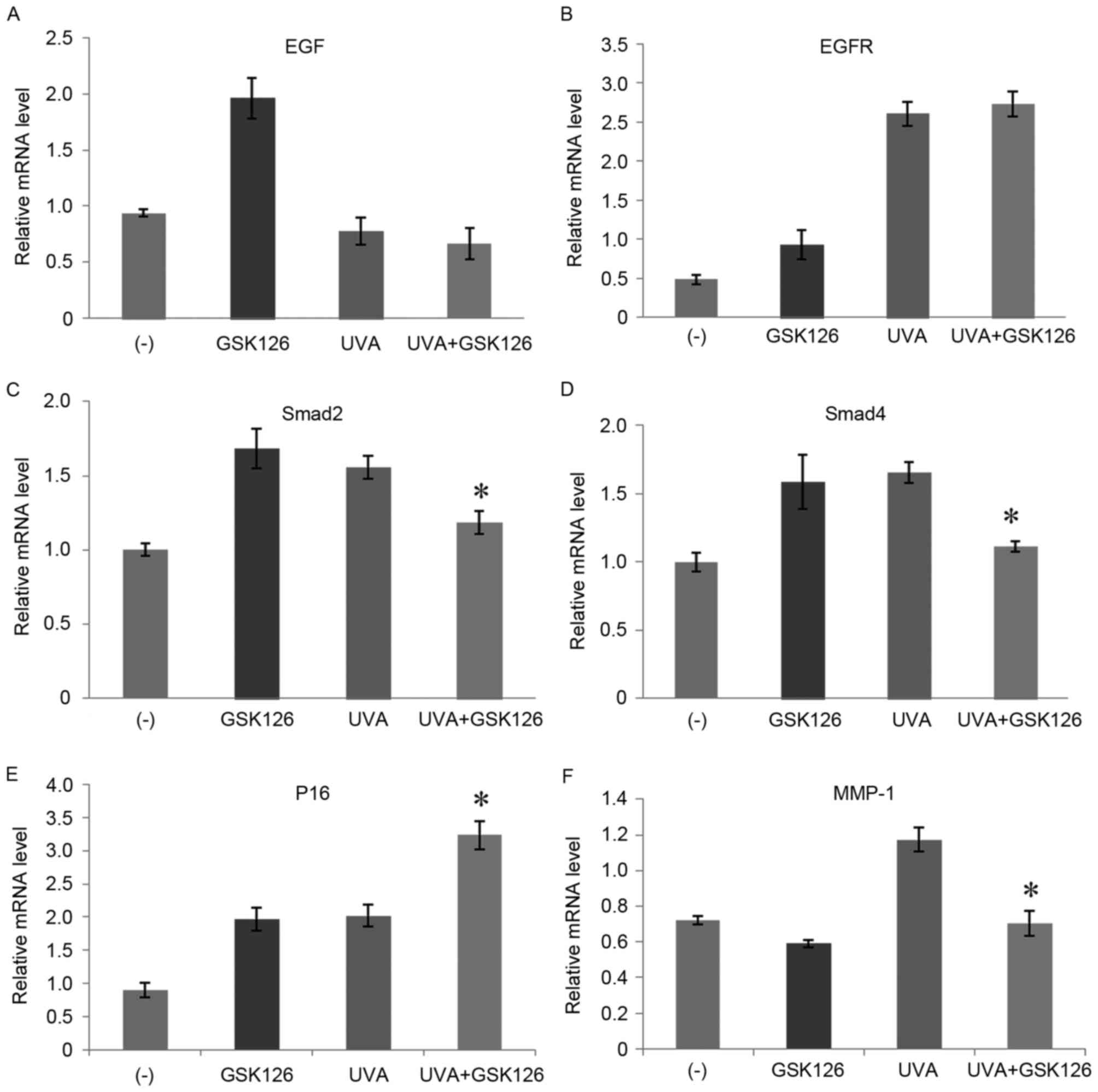|
1
|
Krutmann J, Bouloc A, Sore G, Bernard BA
and Passeron T: The skin aging exposome. J Dermatol Sci.
85:152–161. 2017. View Article : Google Scholar : PubMed/NCBI
|
|
2
|
Peres PS, Terra VA, Guarnier FA, Cecchini
R and Cecchini AL: Photoaging and chronological aging profile:
Understanding oxidation of the skin. J Photochem Photobiol B.
103:93–97. 2011. View Article : Google Scholar : PubMed/NCBI
|
|
3
|
Li W, Zhou BR, Hua LJ, Guo Z and Luo D:
Differential miRNA profile on photoaged primary human fibroblasts
irradiated with ultraviolet A. Tumour Biol. 34:3491–500. 2013.
View Article : Google Scholar : PubMed/NCBI
|
|
4
|
Gilchrest BA: Photoaging. J Invest
Dermatol. 133:E2–E6. 2013. View Article : Google Scholar : PubMed/NCBI
|
|
5
|
Lavker RM: Cutaneous aging: Chronologic
versus photoaging = Photodamage. Gilchrest B: 1st. Wiley-Blackwell;
Cambridge, MA: pp. 123–135. 1995
|
|
6
|
Helfrich YR, Sachs DL and Voorhees JJ:
Overview of skin aging and photoaging. Dermatol Nurs. 20:177–184.
2008.PubMed/NCBI
|
|
7
|
Thangapazham RL, Darling TN and Meyerle J:
Alteration of skin properties with autologous dermal fibroblasts.
Int J Mol Sci. 15:8407–8427. 2014. View Article : Google Scholar : PubMed/NCBI
|
|
8
|
Wong T, McGrath JA and Navsaria H: The
role of fibroblasts in tissue engineering and regeneration. Br J
Dermatol. 156:1149–1155. 2007. View Article : Google Scholar : PubMed/NCBI
|
|
9
|
Fisher GJ, Kang S, Varani J, Bata-Csorgo
Z, Wan Y, Datta S and Voorhees JJ: Mechanisms of photoaging and
chronological skin aging. Arch Dermatol. 138:1462–1470. 2002.
View Article : Google Scholar : PubMed/NCBI
|
|
10
|
Wang Y, Lauer ME, Anand S, Mack JA and
Maytin EV: Hyaluronan synthase 2 protects skin fibroblasts against
apoptosis induced by environmental stress. J Biol Chem.
289:32253–32265. 2014. View Article : Google Scholar : PubMed/NCBI
|
|
11
|
Entwistle J, Hall CL and Turley EA: HA
receptors: Regulators of signalling to the cytoskeleton. J Cell
Biochem. 61:569–577. 1996. View Article : Google Scholar : PubMed/NCBI
|
|
12
|
Ghersetich I: Management of aging skin. J
Eur Acad Dermatol Venereol. 9:511997. View Article : Google Scholar
|
|
13
|
Chen T, Hou H, Fan Y, Wang S, Chen Q, Si L
and Li B: Protective effect of gelatin peptides from pacific cod
skin against photoaging by inhibiting the expression of MMPs via
MAPK signaling pathway. J Photochem Photobiol B. 165:34–41. 2016.
View Article : Google Scholar : PubMed/NCBI
|
|
14
|
Quan T, Qin Z, Xia W, Shao Y, Voorhees JJ
and Fisher GJ: Matrix-degrading metalloproteinases in photoaging. J
Investig Dermatol Symp Proc. 14:pp. 20–24. 2009; View Article : Google Scholar : PubMed/NCBI
|
|
15
|
Hsu LY, Nien CY, Huang WM, Hsu SC and
Chang TC: Synthesis and protective effects of
bis{4-[N,N-di-(carboxymethyl)amino]phenoxy}alkane derivatives on
UVA-induced production of MMP-1 in human skin fibroblasts. Chem
Pharm Bull (Tokyo). 62:867–874. 2014. View Article : Google Scholar : PubMed/NCBI
|
|
16
|
Otte AP and Kwaks TH: Gene repression by
polycomb group protein complexes: A distinct complex for every
occasion? Curr Opin Genet Dev. 13:448–454. 2003. View Article : Google Scholar : PubMed/NCBI
|
|
17
|
Golbabapour S, Majid NA, Hassandarvish P,
Hajrezaie M, Abdulla MA and Hadi AH: Gene silencing and Polycomb
group proteins: An overview of their structure, mechanisms
andphylogenetics. OMICS. 17:283–296. 2013. View Article : Google Scholar : PubMed/NCBI
|
|
18
|
Koubi M, Chabannon C and Duprez E: The
biological complexity of Polycomb group proteins: The case of EZH2.
Med Sci (Paris). 33:499–505. 2017.(In French). View Article : Google Scholar : PubMed/NCBI
|
|
19
|
Gall Trošelj K, Novak Kujundzic R and
Ugarkovic D: Polycomb repressive complex's evolutionary conserved
function: The role of EZH2 status and cellular background. Clin
Epigenetics. 8:552016. View Article : Google Scholar : PubMed/NCBI
|
|
20
|
Narita M, Nũnez S, Heard E, Narita M, Lin
AW, Hearn SA, Spector DL, Hannon GJ and Lowe SW: Rb-mediated matin
formation and silencing of E2F target genes during cellular
senescence. Cell. 113:703–716. 2003. View Article : Google Scholar : PubMed/NCBI
|
|
21
|
Jacobs JL and van Lohuizen M: Polycomb
repression: From cellular memory to cellular proliferation and
cancer. Biochim Biophys Acta. 1602:151–161. 2002.PubMed/NCBI
|
|
22
|
Bernert B, Porsch H and Heldin P:
Hyaluronan synthase 2 (HAS2) promotes breast cancer cell invasion
by suppression of tissue metalloproteinase inhibitor 1 (TIMP-1). J
Biol Chem. 286:42349–42359. 2011. View Article : Google Scholar : PubMed/NCBI
|
|
23
|
Livak KJ and Schmittgen TD: Analysis of
relative gene expression data using real-time quantitative PCR and
the 2(-Delta Delta C(T)) method. Methods. 25:402–408. 2001.
View Article : Google Scholar : PubMed/NCBI
|
|
24
|
Nobile V, Buonocore D, Michelotti A and
Marzatico F: Anti-aging and filling efficacy of six types
hyaluronic acid based dermo-cosmetic treatment: Double blind,
randomized clinical trial of efficacy and safety. J Cosmet
Dermatol. 13:277–287. 2014. View Article : Google Scholar : PubMed/NCBI
|
|
25
|
Kurban RS and Bhawan J: Histologic changes
in skin associated with aging. J Dermatol Surg Oncol. 16:908–914.
1990. View Article : Google Scholar : PubMed/NCBI
|
|
26
|
Quan T, Wang F, Shao Y, Rittié L, Xia W,
Orringer JS, Voorhees JJ and Fisher GJ: Enhancing structural
support of the dermal microenvironment activates fibroblasts,
endothelial cells and keratinocytes in aged human skin in vivo. J
Invest Dermatol. 133:658–667. 2013. View Article : Google Scholar : PubMed/NCBI
|
|
27
|
Werner S, Krieg T and Smola H:
Keratinocyte-fibroblast interactions in wound healing. J Invest
Dermatol. 127:998–1008. 2007. View Article : Google Scholar : PubMed/NCBI
|
|
28
|
Philips N, Tuason M, Chang T, Lin Y, Tahir
M and Rodriguez SG: Differential effects of ceramide on cell
via-bility and extracellular matrix remodeling in keratinocytes and
fibroblasts. Skin Pharmacol Physiol. 22:151–157. 2009. View Article : Google Scholar : PubMed/NCBI
|
|
29
|
Niu T, Tian Y, Cai Q, Ren Q and Wei L: Red
light combined with blue light irradiation regulates proliferation
and apoptosis in skin keratinocytes in combination with low
concentrations of curcumin. PLoS One. 10:e01387542015. View Article : Google Scholar : PubMed/NCBI
|
|
30
|
Lan CC, Ho PY, Wu CS, Yang RC and Yu HS:
LED 590 nm photomodulation reduces UVA-induced metalloproteinase-1
expression via upregulation of antioxidant enzyme catalase. J
Dermatol Sci. 78:125–132. 2015. View Article : Google Scholar : PubMed/NCBI
|
|
31
|
Li DX, Deng TZ, Lv J and Ke J: Advanced
glycation end products (AGEs) and their receptor (RAGE) induce
apoptosis of periodontal ligament fibroblasts. Braz J Med Biol Res.
47:1036–1043. 2014. View Article : Google Scholar : PubMed/NCBI
|
|
32
|
Zhang JW, Zhang SS, Song JR, Sun K, Zong
C, Zhao QD, Liu WT, Li R, Wu MC and Wei LX: Autophagy inhibition
switches low-dose camptothecin-induced premature senescence to
apoptosis in human colorectal cancer cells. Biochem Pharmacol.
90:265–275. 2014. View Article : Google Scholar : PubMed/NCBI
|
|
33
|
Yu A, Zheng Y, Zhang R, Huang J, Zhu Z,
Zhou R, Jin D and Yang Z: Resistin impairs SIRT1 function and
induces senescence-associated phenotype in hepatocytes. Mol Cell
Endocrinol. 377:23–32. 2013. View Article : Google Scholar : PubMed/NCBI
|
|
34
|
Wang YN, Wu W, Chen HC and Fang H:
Genistein protects against UVB-induced senesc-ence-like
characteristics in human dermal fibroblast by p66Shc
down-regulation. J Dermatol Sci. 58:19–27. 2010. View Article : Google Scholar : PubMed/NCBI
|
|
35
|
Aksoy O, Chicas A, Zeng T, Zhao Z,
McCurrach M, Wang X and Lowe SW: The atypical E2F family member
E2F7 couples the p53 and RB pathways during cellular senescence.
Genes Dev. 26:1546–1557. 2012. View Article : Google Scholar : PubMed/NCBI
|
|
36
|
Dhawan S, Tschen SI and Bhushan A: Bmi-1
regulates the Ink4a/Arf locus to control pancreatic beta-cell
proliferation. Genes Dev. 23:906–911. 2009. View Article : Google Scholar : PubMed/NCBI
|
|
37
|
Jacobs JJ, Kieboom K, Marino S, DePinho RA
and van Lohuizen M: The oncogene and Polycomb-group gene bmi-1
regulates cell proliferation and senescence through the ink4a
locus. Nature. 397:164–168. 1999. View
Article : Google Scholar : PubMed/NCBI
|
|
38
|
Lee BM, Han DG and Choi WS: Rejuvenating
effects of facial Hydrofilling using Restylane vital. Arch Plast
Surg. 42:282–287. 2015. View Article : Google Scholar : PubMed/NCBI
|
|
39
|
Simpson RM, Wells A, Thomas D, Stephens P,
Steadman R and Phillips A: Aging fibroblasts resist phenotypic
maturation because of impaired hyaluronan-dependent CD44/epidermal
growth factor receptor signaling. Am J Pathol. 176:1215–1228. 2010.
View Article : Google Scholar : PubMed/NCBI
|
|
40
|
Wang Y, Chen H, Wang W, Wang R, Liu ZL,
Zhu W and Lian S: N-terminal5-merpeptideanalog P165 of amyloid
precursor protein inhibits UVA-induced MMP-1expression by
suppressing the MAPK pathway in human dermal fibroblasts. Eur J
Pharmacol. 734:1–8. 2014. View Article : Google Scholar : PubMed/NCBI
|
|
41
|
Chiang HM, Chen HC, Lin TJ, Shih IC and
Wen KC: Michelia alba extract attenuates UVB-induced expression of
matrix metalloproteinases via MAP kinase pathway in human dermal
fibroblasts. Food Chem Toxicol. 50:4260–4269. 2012. View Article : Google Scholar : PubMed/NCBI
|
|
42
|
Hensley K and Floyd RA: Reactive oxygen
species and protein oxidation in aging: A look back, a look ahead.
Arch Biochem Biophys. 397:377–383. 2002. View Article : Google Scholar : PubMed/NCBI
|
|
43
|
Kretova M, Sabova L, Hodny Z, Bartek J,
Kollarovic G, Nelson BD, Hubackova S and Luciakova K:
TGF-β/NF1/Smad4-mediated suppression of ANT2 contributes
tooxidative stress in cellular senescence. Cell Signal.
26:2903–2911. 2014. View Article : Google Scholar : PubMed/NCBI
|



